Final Report for LNC12-347
Project Information
Our preliminary year of 2012 and our first full year of 2013 proved to be challenging with great successes and incredible challenges for this cover crop project. We had to completely rethink the direction of our work with radish, but we were also able to intermate eight accessions identified as especially noteworthy to form a new composite radish population.
Progress with cowpea as a cover crop was rapid, and we found about a dozen accessions for regional evaluation in 2014 after farmers and agronomists chose what they saw as the most promising. There were crop failures with cowpeas at two sites, but we continued to learn a great deal about this crop. Wet, cold weather also made our work with radish very difficult, but our second season of mating did return us enough seeds for continued seed increases with a new population. In 2015 we continued radish work via an organic, on-farm seed increase in North Dakota, radish demonstration plots at three university centers, and an initial evaluation of our intended method for rapid radish breeding in the upper Midwest.
Cowpea evaluations were planted at five locations in 2015, and in 2016 at three more, although hail destroyed one of them. Initial seed increases for commercial production of cowpea began in 2016, and we also carried out an initial evaluation of our radish population with several that are currently available commercially. We found several very promising cowpea accessions that are moving towards commercialization and further breeding opportunities thanks to regional trials and input from farmers, researchers and seed producers. Our radish work is further behind, but the new composite population is available for increase for initial cover crop seed sales in a couple years, and we have begun mass selection for the cover crop type we need in the North for eventual release of an improved version.
Introduction:
The use of cover crops continues to increase as farmers seek to improve soil quality, reduce chemical inputs, and maintain profitability. Research and grower experiences in the North Central Region have demonstrated that cover crops can help to achieve these benefits, and the Environmental Quality Incentives Program (EQIP) program has payments for cover crop practices. The National Organic Program’s (NOP) regulations on annual seeds (including cover crop seeds) state that organically grown seeds must be used, when commercially available. Organic, low-input farmers frequently lack seed varieties that are adapted to their cropping systems, and demand for certified organic cover crop seed is greater than supply. Therefore, organic, cover crop seed is often expensive or unavailable for organic farmers seeking to employ them for sustainability benefits. A change is needed.
Most cover crop research has focused on documenting benefits and management, emphasizing proper choices of cover crop species and management to maximize benefits and reduce problems. However, little attention has been paid to varietal selection within species and to seed availability. Most cover crop seed is sold by species, not variety, marked VNS (Variety Not Specified). This can result in unknown traits and performance from the seed, and there have been failures of cover crop seed in the North Central Region due to poor adaptation of unidentified cover crop varieties.
The Northern Plains Sustainable Agriculture Society (NPSAS) Farm Breeding Club (FBC) was formed with the purpose of fostering farmer collaboration with public breeders and research agronomists in the evaluation and development of crop varieties suitable to organic and low-input farming systems.
The FBC chose to work on radish and cowpea as cover crops after Burleigh County farmers identified them as priorities in their no-till systems. Forage radish, a cool season cover crop, and cowpea, a warm season cover crop, not only enhance soil quality but can serve multi-purpose roles as cover and fall grazing crops. In addition, both species winter-kill, presenting no carry-over issues in the following year’s crops and providing no-till and organic farmers with an ideal seedbed. To meet these needs and potential opportunities in the northern parts of the North Central Region, we need to find appropriate and productive varieties of these two crops.
Cowpea, an annual legume originally from Africa, has been demonstrated to be a useful forage and cover crop in the upper Midwest, and it was being bred for the seed production in the region at the University of Minnesota in the 1980s. A couple of those lines from Minnesota appear to have been maintained among the Seed Savers Exchange, and other early accessions of cowpea exist in the world collection at the USDA National Plant Germplasm System. If varieties can be found that both produce vigorous, sizable plants and dry seed within our short, northern growing seasons, then cowpea could be a popular cover and forage crop that is also a viable option for seed producers in the North Central Region, including organic seed producers. 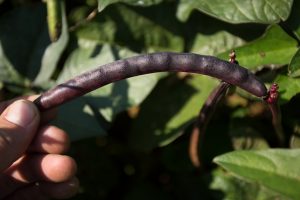 Cowpeas vary in color, maturity, plant form, and other traits like other pulse crops. Some look adaptable to the upper Midwest. Daikon or big-rooted radish is a biennial, and somewhat more complicated to work with than cowpea. It is well adapted to the western Cascades region where it can be planted, over-wintered in place, and then produce seeds. These large roots do not survive the winters of the North Central Region. However, radish is grown for seed on the northern plains when it is planted very early in the season to achieve the necessary level of vernalization so it will flower. Farmers would like radish cover crops that do not bolt and go to seed, so selection for improvement on the northern plains is a challenge. To best meet the needs, radish should be planted in August like farmers normally do, selection of rapidly growing roots of the sort most likely to benefit soil conditions should be carried out, these somewhat undersized roots need to be stored safely through the winter, and then these should be planted out the following spring to flower and form an improved generation of this population. Recurrent mass selection of this sort is expected to rapidly improve the population for cover crop purposes in the upper Midwest (selection and recombination in two summers).
Cowpeas vary in color, maturity, plant form, and other traits like other pulse crops. Some look adaptable to the upper Midwest. Daikon or big-rooted radish is a biennial, and somewhat more complicated to work with than cowpea. It is well adapted to the western Cascades region where it can be planted, over-wintered in place, and then produce seeds. These large roots do not survive the winters of the North Central Region. However, radish is grown for seed on the northern plains when it is planted very early in the season to achieve the necessary level of vernalization so it will flower. Farmers would like radish cover crops that do not bolt and go to seed, so selection for improvement on the northern plains is a challenge. To best meet the needs, radish should be planted in August like farmers normally do, selection of rapidly growing roots of the sort most likely to benefit soil conditions should be carried out, these somewhat undersized roots need to be stored safely through the winter, and then these should be planted out the following spring to flower and form an improved generation of this population. Recurrent mass selection of this sort is expected to rapidly improve the population for cover crop purposes in the upper Midwest (selection and recombination in two summers).
Original Objective 1. Increase access to cowpea seed varieties with useful cover crop traits and the ability to mature quality seed in northern climates.
- Activity 2013. Conduct multi-location screen of 25-40 cowpea varieties in spring seed production and late summer cover crop evaluations.
- Activity 2013-2014. Conduct winter nursery seed increases of 8-12 top ranked cowpea varieties.
- Activity 2014. Conduct multi-location variety trial of 8-12 cowpea varieties.
- Activity 2014-2015. Conduct winter nursery seed increases of 2-4 top ranked cowpea varieties.
- Activity 2015. Conduct multi-location variety trial of 2-4 cowpea varieties and three commercial check varieties.
Original Objective 2. Increase access to forage radish seed with useful cover crop traits and the ability to mature quality seed in northern climates.
- Activity A1. Plant roots of a pre-selected forage radish bulk population in seed-to-root-to-seed production plots in 2013, 2014, 2015. Harvest seeds by mid-summer.
- Activity A2. Plant harvested seeds to cover crop trials in mid-summer; dig, evaluate, select, and overwinter roots for ongoing selection and improvement.
Objectives for 2016 Extension:
- Carry out additional replicated evaluations of our remaining six cowpea accessions and two controls at three locations.
- Move some accessions towards commercial production based on farmer/researcher/seed producer choices.
- Carry out replicated evaluations of our radish population and other commercially available daikon radish populations at three locations.
- Complete radish root-to-seed-to-root selection and begin another round of selection.
- Conduct field days, workshops, and other outreach to keep NPSAS members and the wider public aware of our progress and the importance of cover crops.
Cooperators
Research
Cowpeas:
Before SARE funding expanded our project, NPSAS, NDSU, and NRCS performed a screen of 10 accessions of cowpeas (provided by the USDA National Plant Germplasm System) near Belfield, ND in 2011 and over 90 accessions of cowpeas (provided by the USDA National Plant Germplasm System) at Bismarck and Carrington, ND in 2012. Seed from the three accessions that matured seeds in 2011 and from the eighteen accessions that matured some seeds in 2012 were sent to the University of Puerto Rico for increase over the winter of 2012-2013. Seeds of five more varieties available commercially or via Seed Savers Exchange were also sent along to provide additional insights into early cowpeas. A total of 25 varieties were sent for increase and seeds of 23 of the varieties came back in spring of 2013, with one variety increased up to 17 pounds from 100 feet of row. There were enough seeds from 21 of the varieties to use in replicated trials that summer at Dickinson, ND, Carrington, ND, Beresford, SD, and Madison, WI. 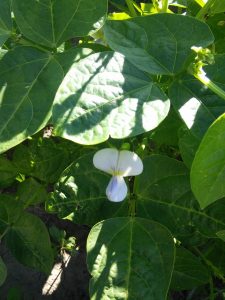 An early cowpea variety flowering in Minnesota. Seed was germination tested and seed counts were determined before shipping seeds and OMRI approved inoculant (Guard-N) to each university collaborator in 2013. Three replicates for seed production were planted in early June with a goal density of four plants per foot. A similar set of replicates was planted after local small grain harvest at each location. Plots at most locations were two rows, twenty-five feet in length, while plots in Wisconsin were three rows, eight feet in length. Row widths were 2.5 feet. Plots were on organically managed ground at each location, and we controlled weeds with mechanical cultivation. Emergence was determined as days from planting to 50% emergence. Seedling vigor was rated on a 1-5 scale two weeks after first emergence. Plant form was rated as erect vs spreading and vining vs determinate. Canopy closure within rows was rated on a 1-5 scale five weeks after emergence. Days to flowering was determined as days from planting to 50% flowering, and days to physiological maturity was determined as days from planting to 80% tan pod color (R9). Yield of seed was calculated as pounds per acre, and seeds were counted and weighed to determine 1000 seed weight in grams. The cover crop trial was evaluated in a similar manner, although dry biomass was calculated as pounds per acre from a sample of at least six feet of row. At Wisconsin 3-5 plants of each variety were also dug and the number of root nodules counted. Cover crop trials did not establish in North Dakota, but were successful in South Dakota and Wisconsin. Seed was harvested at all locations. Data were summarized across the locations and discussed among FBC members and participating scientists to choose those to move forward. We then sent seeds of twelve varieties (ten USDA NPGS accessions and two commercially available varieties) to Puerto Rico for further increase. This increase was very successful, with up to 60 pounds returned for several of the varieties. Seed was germination tested and seed counts were determined before shipping seeds and OMRI approved inoculant to each location for continued trials.
An early cowpea variety flowering in Minnesota. Seed was germination tested and seed counts were determined before shipping seeds and OMRI approved inoculant (Guard-N) to each university collaborator in 2013. Three replicates for seed production were planted in early June with a goal density of four plants per foot. A similar set of replicates was planted after local small grain harvest at each location. Plots at most locations were two rows, twenty-five feet in length, while plots in Wisconsin were three rows, eight feet in length. Row widths were 2.5 feet. Plots were on organically managed ground at each location, and we controlled weeds with mechanical cultivation. Emergence was determined as days from planting to 50% emergence. Seedling vigor was rated on a 1-5 scale two weeks after first emergence. Plant form was rated as erect vs spreading and vining vs determinate. Canopy closure within rows was rated on a 1-5 scale five weeks after emergence. Days to flowering was determined as days from planting to 50% flowering, and days to physiological maturity was determined as days from planting to 80% tan pod color (R9). Yield of seed was calculated as pounds per acre, and seeds were counted and weighed to determine 1000 seed weight in grams. The cover crop trial was evaluated in a similar manner, although dry biomass was calculated as pounds per acre from a sample of at least six feet of row. At Wisconsin 3-5 plants of each variety were also dug and the number of root nodules counted. Cover crop trials did not establish in North Dakota, but were successful in South Dakota and Wisconsin. Seed was harvested at all locations. Data were summarized across the locations and discussed among FBC members and participating scientists to choose those to move forward. We then sent seeds of twelve varieties (ten USDA NPGS accessions and two commercially available varieties) to Puerto Rico for further increase. This increase was very successful, with up to 60 pounds returned for several of the varieties. Seed was germination tested and seed counts were determined before shipping seeds and OMRI approved inoculant to each location for continued trials.
Seed evaluation plots were again planted late due to the extended rain and cold in the spring of 2014. Rain prevented weed control at the South Dakota site and those plots were terminated. Cold continued throughout the summer and only one variety matured seeds in Dickinson, ND. Plants were stressed at the Carrington, ND and Arlington, WI sites but full maturity was achieved at these locations. Late planted cowpeas for the cover crop trial failed in North Dakota and were not attempted in South Dakota, so only Wisconsin was able to get cover crop data for this planting period in 2014. 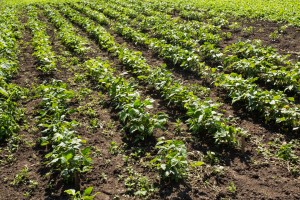 Late planted cowpeas grew well enough to provide cover crop and forage opportunities in southern Wisconsin.
Late planted cowpeas grew well enough to provide cover crop and forage opportunities in southern Wisconsin.
Storage of the seeds, however, hit a big difficulty by mid summer of 2014 as hundreds of cowpea weevils (Callosobruchus maculatus) began emerging and overrunning our storage space. Seed was bagged in an extra garbage bag and frozen for a week in order to kill these pests. That and freezing over the winter seems to have ended the infestation in the extra seeds that remained in storage. We made sure to freeze all future seed going into storage for several weeks to control this pest. Cowpea weevils were a problem in seed coming back from Puerto Rico. Freezing the seed eliminated this problem in storage.
We summarized the results from 2014 and again sent it out to scientists and FBC members to help choose the varieties we wanted to move forward for the last year of work. We sent six accessions identified from our results in 2014 as being especially promising (PI 293499, PI 293525, PI 293570, PI 352903, PI 493446, and PI 493468) and two commercial controls (Iron and Clay, Red Ripper) to Bryan Brunner at the University of Puerto Rico research station in Lajas for increase in January, 2015. The growing season in the winter of 2014-2015 was very wet and the seed was planted late. It was also later to mature and to receive back in North Dakota, so seed was shipped to collaborators in North Dakota (Pat Carr, Steve Zwinger, Hans Kandel), South Dakota (Peter Sexton), Minnesota (Tom Michaels), and Wisconsin (Erin Silva) in late May. Remaining seed was frozen for several months and trials conducted as before. Since late planted cowpeas had failed for two years, the North Dakota sites planted their cover/forage crop trial in early July, the time when many ranchers there are planting cover/forage crop mixes.  The organic winter nursery in Puerto Rico was essential for moving our evaluations forward.
The organic winter nursery in Puerto Rico was essential for moving our evaluations forward.
We applied for and were awarded an extension to finish out the project in 2016. University collaborators at Carrington, ND, St. Paul, MN, and Arlington, WI planted cowpea seed production plots as they did in previous years. Hail destroyed the plots in North Dakota, but yield data and other information was collected at the other two sites. FBC members used a summary of the data to identify varieties they felt were most likely useful for their farms. Remnant seed was provided to PulseUSA for increase and commercialization. They planted out seed increase fields in the Dakotas in 2016 with the goal of some sales perhaps as early as 2018. One accession failed at increase, so the backup seed of that accession (PI 293570) was sent back to Puerto Rico in December, 2016 for increase and later commercialization.
Radish:
FBC member Emily Stiegelmeier conducted a screen of fifty-four accessions of big rooted radishes from the USDA National Plant Germplasm System on her South Dakota farm in 2011. A group of FBC members helped to dig and evaluate roots in October of that year and posted a video about the process. Storage of these selected, but not fully matured, roots in a refrigerator proved difficult and failed. Emily replanted remnant seeds of the very best accessions in 2012, saving seeds from the plants that made seeds by late August from a May planting and also making additional root selections from a late planting of these exceptional varieties. However, as in 2011, she was unable to keep the small roots of the late-planted accessions through the winter for replanting in the spring, and seed production via this seed-to-root-to-seed method did not materialize as we had intended. FBC members did discuss the progress and challenges of our work with radishes during the member update workshop at the NPSAS Winter Conference in Aberdeen, SD in January, 2013. Our SARE project work with radish was to build on Emily’s on-farm selections, but with no roots and very little seed we were greatly hampered in that objective and had to start over.
FBC choose eight of the top performers from Emily’s 2011 evaluation (Table 1) and Kat Becker planted them on her farm in Wisconsin as early as she could, given the wet and cold spring they were having in 2013. Kat harvested seed from this mixed planting later in the summer.
Table 1. Radish accessions selected from 2011 screen in South Dakota.
| Accession | Name | Origin |
| PI 217961 | Pakistan | |
| PI 263262 | Minowase | Japan |
| PI 263263 | Miyashige | Japan |
| PI 268370 | Mul-ey | Afghanistan |
| PI 269589 | Pakistan | |
| PI 271517 | India | |
| PI 286432 | Nepal | |
| PI 391632 | Chuan Xin Hong | China |
Kat Becker grew out a large seed increase plot of radish in 2014 from the seeds of these accessions that were intermated in 2013. This summer was similarly cold and damp, which resulted in very low increase of seed, with only two pounds of clean seed for planting in 2015. However, this additional generation should have resulted in further genetic recombination and a new composite population was born.
Although our supply of radish seeds was not very large after the wet year in 2014, Owen Trangsrud planted most of the two pounds of seed on his farm near Enderlin, ND as early as he could in spring of 2015. This worked to vernalize and promote flowering in radish in all of our experimental plantings in North Dakota and Wisconsin, and it was again successful. Just over ten pounds of organically grown radish seed resulted. With the very late fall in 2015, we were unexpectedly able to continue our radish work in November. There were a large number of volunteer radish roots that established after Owen’s seed harvest in August. As these started growing at about the time most late cover crops are planted, we were able to dig and inspect the roots and evaluate the diversity of the new population and its ability to grow big roots quickly while not bolting too early. Harvested radish roots for seed production (stecklings) were first trimmed of all of their leaves. They were then immediately sent to Hugh Dufner’s potato storage facility in Minnesota to see if we could successfully store these somewhat immature roots long enough to plant them out for intermating and seed increase in the spring of 2016. Successful storage would show that the seed to root to seed approach could work even in North Dakota when careful storage with high humidity is provided. Owen also mulched some of the remaining volunteer plants to see if that would be enough to safely overwinter the roots in place. Additional selection with the same population was conducted in South Dakota in 2016. A strip of about one acre was planted with the FBC experimental plot drill at Emily Stiegelmeier’s organic farm near Selby, SD in August. In early November roots were again dug, selected, trimmed, and stored in Minnesota for ongoing selection work. In 2015 radish variety demonstrations were also planted at Carrington, ND and Arlington, WI with FBC seeds and seed of other radish varieties donated by Gabe Brown (Bismarck, ND) and La Crosse Seed. These were standard small plots and were featured during station field events to highlight our project and radish as a cover crop.
In 2016 radish variety trials with the same varieties were planted at three locations (Carrington, ND, St. Paul, MN, and Arlington, WI) in August. Plots were five x twenty feet in size and seed was planted at 10 lbs/A in North Dakota and Wisconsin. The plots were of similar size in Minnesota but the seed was broadcast at a rate of about 15 lbs/A. Vigor was rated on a 1-5 scale two weeks after emergence and ground cover visually estimated later in October. Plants were counted in three 0.1 m2 subplots and averaged. At the Carrington site, plants and roots in these subplots were also harvested and dried to estimate biomass on a per acre basis. Data analysis for the cowpea work is ongoing, and we have a goal of a research publication to describe the work. Our simple Randomized Complete Block design for the radish variety trial was analyzed for each location using ANOVA and Least Significant Difference tests. Results for the initial radish variety trial and our first successful selections with radish will be shared with farmers via NPSAS outreach channels.
Cowpea:
Cowpea data was collected together and average performance determined across four years of evaluation (14 site years), although all parameters were not evaluated at each location each season. Hail, cold weather, and weeds caused a few crop failures. Data could not be collected from late plantings in North Dakota as establishment was weak and growth slowed severely by cool weather. Late plantings were successful in southeastern South Dakota and southern Wisconsin, and cover crop data was collected there. Estimates of cover and biomass from cover/forage plantings in North Dakota were only possible when cowpeas were planted before mid July. Cowpeas are a crop developed in Africa and largely grown in the southern USA. However, results with six of the accessions over these years showed clearly that some have promise for seed production as far north as central North Dakota (Tables 2a and 2b). Emergence took place within 9-11 days, and flowering within 57-62 days. Generally, maturity was within about three months. Crop failure only took place when weather was very cold and wet, limiting growth or preventing weed control, or from hail which is always a risk for every seed crop. 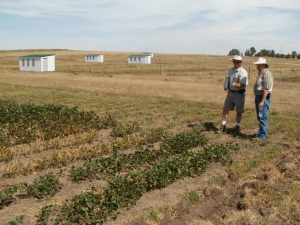
Some varieties of cowpeas proved able to mature even in western North Dakota in some years. During a 2015 field day accessions were rated for seed and cover crop potential. Yields of seed varied among the varieties (means not yet tested), although several looked very promising. One accession, PI 293525, had trouble with establishment of good stands and its yields and cover were therefore limited by what appears to possibly be cold sensitivity at germination. These plants grew well once started, but the thin stands prevented this variety from being dependable at northern sites in Minnesota and North Dakota. A group of farmers and agronomists evaluated the experimental and check varieties at Prosper, ND in 2015. Cover for the accessions was one third to two thirds of that of the checks (Iron and Clay, Red Ripper), which grow well but produce little seed here. Red Ripper does produce some seed in central parts of our region (southeastern South Dakota and southern Wisconsin) and very little further north. Iron and Clay did not produce seed of any amount at most of our locations. Two of the experimental varieties looked much more adapted to farming systems here due to their likelihood of easy harvest, but the slow dry down of cowpeas in general (shown by maturity ratings) did look challenging. 2017 Cowpea Summary Tables
Table 2a. Summary of results for six accessions of cowpea evaluated across the North Central Region from 2013-2016. Means are based on evaluations in fourteen environments, although the parameters were not all measured in all locations and years.
| VARIETY | Days to Emerge | Early Vigor Rating | Canopy Rating | Days to Flower | Days to Maturity | Yield (lbs/A) |
| PI 293499 | 10.2 | 4.3 | 3.4 | 61.4 | 91.0 | 1149.4 |
| PI 293525 | 10.7 | 3.2 | 3.0 | 61.5 | 90.6 | 897.3 |
| PI 293570 | 9.0 | 4.8 | 3.5 | 60.2 | 91.8 | 1062.3 |
| PI 352903 | 9.9 | 3.1 | 3.5 | 60.8 | 93.5 | 986.7 |
| PI 491446 | 10.3 | 3.8 | 2.9 | 57.1 | 91.7 | 936.5 |
| PI 491468 | 10.4 | 3.9 | 3.1 | 60.9 | 90.9 | 714.0 |
Table 2b. Summary of results for six accessions of cowpea evaluated across the North Central Region from 2013-2016. Means are based on evaluations in fourteen environments, although the parameters were not all measured in all locations and years.
| VARIETY | Dry Wt - E Planting (lb/A) | Dry Wt - L Planting (lb/A) | 1000 seed wt (g) | Farmer Rating: Harvestability | Farmer Rating: Maturity | Farmer Rating: % Cover |
| PI 293499 | 3820.8 | 1037.7 | 138.5 | 6.25 | 5 | 55 |
| PI 293525 | 3566.0 | 705.8 | 135.3 | 4.25 | 5.25 | 26.25 |
| PI 293570 | 3014.4 | 684.1 | 166.7 | 4.625 | 5 | 51.25 |
| PI 352903 | 3685.9 | 948.2 | 78.2 | 5.5 | 5.75 | 61.25 |
| PI 491446 | 4060.0 | 844.6 | 114.1 | 7.25 | 5.75 | 33.75 |
| PI 491468 | 2458.7 | 820.8 | 81.5 | 3.75 | 4.5 | 56.25 |
PulseUSA, a seed grower cooperative, began increasing seeds of four of the cowpea accessions in 2016 at conventional sites in the eastern parts of the Dakotas. A dessicant was used on conventional fields to dry down this crop because it often remains green even when the pods are fully dry. A crop failure took place with one, PI 293570, which was planted in far western North Dakota. Remnant seed of this accession was sent to Puerto Rico for increase during the winter of 2016-2017. Seed of others was increased to hundreds of pounds, and PulseUSA is currently looking for organic growers to further increase seed in 2017. Although the initial impulse of this project was to grow these cowpeas for cover crop uses, potential food markets are also of great interest to the pulse growers in North Dakota. We have been told that cowpea is of great interest in some foreign markets for food uses, and we know it is traditionally used this way in the southern USA. Tom Michaels has talked with Somali immigrants in the Twin Cities and found that small, red seeded varieties would be most interesting for that food market. Now that we have several promising varieties for local production, we look forward to further developments in both food and cover crop markets and the potential of future breeding to better meet market needs.
Radish:
The increase of radish seed in 2015 resulted in about 10 pounds of seed for further increase and selection in 2016. Roots dug from volunteer plants in 2015 stored through the winter quite well under the conditions used to keep potato tubers (cold and high humidity). Most of the roots were healthy enough for replanting and nearly 200 of them successfully went to seed on a Minnesota farm in 2016, marking our first completion of this life cycle. Roots that were mulched in a North Dakota field survived the winter until they were uncovered, however, a cold snap in late March caused considerable damage. As the winter of 2015-2016 was also a warm winter, selecting roots and holding them over in the field may not be dependable for large-scale work. 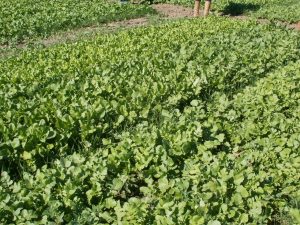 The 2016 radish variety trial provided our first good evaluation of our new radish population (seen in the middle) and other large rooted varieties. Comparison of our new population with commercially available daikon radish varieties in the 2016 variety trial showed that it was fairly similar in performance (Tables 3a and 3b). Seed quality varied enough to have a large impact on the results, with Graza clearly having germination issues from two year old seeds, and variation in plant stands suggests further evaluation could be very useful. This is especially true to clearly identify the significance of differences in biomass production above and below the ground, which look very interesting and are of great importance for farmers and ranchers. 2017 Radish Summary Tables
The 2016 radish variety trial provided our first good evaluation of our new radish population (seen in the middle) and other large rooted varieties. Comparison of our new population with commercially available daikon radish varieties in the 2016 variety trial showed that it was fairly similar in performance (Tables 3a and 3b). Seed quality varied enough to have a large impact on the results, with Graza clearly having germination issues from two year old seeds, and variation in plant stands suggests further evaluation could be very useful. This is especially true to clearly identify the significance of differences in biomass production above and below the ground, which look very interesting and are of great importance for farmers and ranchers. 2017 Radish Summary Tables
Table 3a. Results from 2016 radish variety trial at three locations.
| Stand (Plants/0.1m^2) | Vigor Rating | ||||
| Variety | Carrington | St Paul | Arlington | Carrington | Arlington |
| FBC bulk | 3.7 b | 20.3 a | 10.2 a | 4.0 a | 3.7 abc |
| Graza | 1.4 c | 2.1 c | 0.9 c | 1.0 b | 1.0 d |
| Jackhammer | 5.5 ab | 3.0 a | |||
| Minowase | 6.8 a | 18.7 a | 8.9 ab | 4.0 a | 4.3 a |
| Miyashige | 4.9 ab | 12.6 b | 6.3 b | 2.8 a | 2.3 cd |
| Nitro | 5.0 ab | 15.3 ab | 6.3 b | 2.8 a | 2.7 bc |
| Tillage Radish | 4.6 b | 15.4 ab | 7.7 ab | 3.8 a | 4.0 ab |
Table 3b. Results from 2016 radish variety trial at three locations.
| % Cover | Tops Yield (lbs/A) | Root Yield (lbs/A) | ||
| Variety | St Paul | Arlington | Carrington | Carrington |
| FBC bulk | 85.0 a | 93.3 a | 2343 bc | 2000 c |
| Graza | 31.1 b | 37.2 b | 2215 c | 2277 bc |
| Jackhammer | 2551 bc | 2438 abc | ||
| Minowase | 89.4 a | 96.1 a | 3463 a | 2269 bc |
| Miyashige | 86.1 a | 88.9 a | 3025 abc | 2321 bc |
| Nitro | 93.3 a | 92.8 a | 3222 ab | 2740 ab |
| Tillage Radish | 86.1 a | 93.9 a | 2975 abc | 2876 a |
Agronomists and farmer evaluators noted that the radish varieties were largely green with white midribs in the leaves and mostly white roots, but that the FBC population also includes many plants with purple or red in the leaf petioles, leaf midribs and the roots. We have decided to select for this colorful trait to help differentiate our variety once it comes to the marketplace. Tom Michaels at the University of Minnesota - Twin Cities also noted that the leaf margins for the FBC population has undulate leaf margins whereas the commercial daikon varieties usually have dentate or serrate leaf margins. Tom also plotted the plant counts by the cover data and showed very clearly the plastic nature of radish plant growth (Figure 1). The Graza variety had very low plant counts and cover due to germination issues, but the others were fairly similar. He noted that stands of 8-10 plants per 0.1 m2 often had as much cover as stands with over 20 plants. Plants at low stand numbers apparently increased in size in some way to make use of the extra resources and plants at high densities showed some limitation in growth. Steve Zwinger also observed a low amount of bolting in the FBC population by early November, although the significance of that is not entirely clear yet. We are certainly selecting against early bolting and will continue to do so. While we have some selected roots in storage for further breeding activities in 2017, we also have remnant seed from the 2015 increase. This seed appears to be generally as useful as other currently available daikon radish seed used in commerce and plans are to increase it for organic seed sales in the upcoming years while we breed an improved version for release.
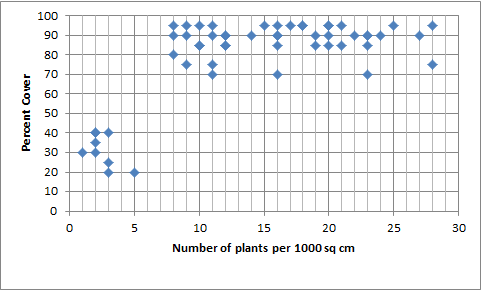
Figure 1. Plot of cover vs. plant stand from radish variety trial in St. Paul, MN in 2016.
- Additional researchers joined the project after hearing of it via outreach activities. This included a year of evaluations of cowpeas at Prosper, ND and two years of evaluations at St. Paul, MN. - Seeds of four of our experimental cowpea accessions are being increased for commercial sales by 2018. This is largely due to field days and other outreach efforts that presented our cowpea results to seed producers in North Dakota. 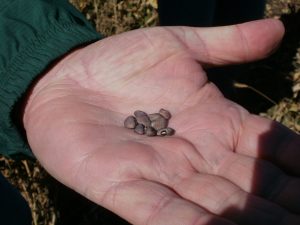 One of four cowpea accessions on its way to commercialization in the Dakotas. - Seed of a new composite daikon radish population is being increased for commercial sales, possibly by 2018. - A method for growing and selectively breeding daikon radish on the northern plains was worked out. Careful harvest and storage of stecklings in potato storage conditions appears to be the key. This now guides our radish breeding work. - Forty to sixty attendees at the organic field days in Carrington, ND in July 2013, 2014, and 2015 heard about the cover crop project, were able to see the early growth in the cowpea trial, and were able to visually compare radish varieties (2015). Eight more attended a fall event there in 2016 to evaluate radishes. Project plots were also featured at field events at Beresford, SD in 2013, Prosper, ND in 2015, Dickinson, ND in 2015, and at Arlington, WI throughout the project. The outcome of this was increased awareness of our project and varietal differences in cover crop species.
One of four cowpea accessions on its way to commercialization in the Dakotas. - Seed of a new composite daikon radish population is being increased for commercial sales, possibly by 2018. - A method for growing and selectively breeding daikon radish on the northern plains was worked out. Careful harvest and storage of stecklings in potato storage conditions appears to be the key. This now guides our radish breeding work. - Forty to sixty attendees at the organic field days in Carrington, ND in July 2013, 2014, and 2015 heard about the cover crop project, were able to see the early growth in the cowpea trial, and were able to visually compare radish varieties (2015). Eight more attended a fall event there in 2016 to evaluate radishes. Project plots were also featured at field events at Beresford, SD in 2013, Prosper, ND in 2015, Dickinson, ND in 2015, and at Arlington, WI throughout the project. The outcome of this was increased awareness of our project and varietal differences in cover crop species. 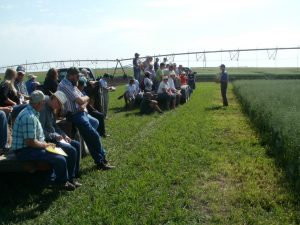 Field day attendees heard about our cover crop project among many other exciting developments. - Four attendees helped to evaluate the cowpeas at Carrington in September 2014.
Field day attendees heard about our cover crop project among many other exciting developments. - Four attendees helped to evaluate the cowpeas at Carrington in September 2014.
A video of the cowpea plots during this field event was posted to YouTube to allow others to help evaluate the cowpeas (Participatory Evaluation of Cowpea Varieties for Northern Regions). It has had 240 views by March 2017. We also posted a video of how plots looked in Dickinson, ND in 2015 (https://youtu.be/gj_gdH7wNRU; 179 views), a video of how plots looked in St. Paul, MN in 2015 (https://youtu.be/bMsDowxSiJU), and a video of how plots looked in Arlington, WI in 2015 (https://youtu.be/GXdZwIaWJSQ). Because the seeds varied in their attractiveness, we also posted a video about what the cowpea seed looks like (https://youtu.be/6WANW5YPXUg; 226 views by March 2017).
Together these videos gave farmers at our workshops a better feel for the varieties when selecting those we wanted to continue to grow. - Our initial radish root selection in 2015 was recorded in a YouTube video (https://youtu.be/EFDQS9a3Xeg) and has had 188 views since then. We also posted a video about the critical traits for radish in cover crop applications (https://youtu.be/jpR-49Jxpxg; 70 views). - Updates about the cover crop project were shared via the NPSAS Germinator newsletter and the NPSAS Farm Breeding Club Facebook page. The Germinator gets to all 400 plus members of NPSAS and the FBC Facebook page that has 916 likes as of March 2017. An impact of this was increased awareness of cover crops, these two species, and all of our project activities.
Economic Analysis
No economic analyses were performed.
Farmer Adoption
No analysis of farmer adoption was undertaken. However, a seed grower cooperative has adopted four of our cowpea accessions for increase and commercial sales.
Educational & Outreach Activities
Participation Summary:
NPSAS and NDSU Carrington Research Extension Center held a joint organic agriculture field day in July, 2013 and the cowpea planting was featured during this event which had 41 people in attendance. One highlight was the enthusiasm demonstrated by a Korean professor and a Nigerian technician who made clear that cowpea could also be an excellent food crop if we expanded our consideration.
Our cover crop work continued to be featured at field days there every summer until 2015 with crowds that at times reached 60 attendees. We also included fall field days to evaluate cowpeas (2014) and radishes (2016), and those had four and eight attendees each. Cowpeas were also a featured stop during the annual summer field day at the NDSU Dickinson Research Extension Center in 2013 and 2015, and at an evaluation field day in September, 2015 that had two attendees. The SDSU Beresford station included cowpea plots in their annual field day in 2013, and NDSU partnered with NPSAS for a field evaluation of cowpeas in September of 2015 near Prosper, ND. Three people attended that event.
The Burleigh County Soil Conservation District planted demonstration plots of radish at the Menocken Farm in 2015, but these were unfortunately sprayed out before their field day. We also held a field day at the Trangsrud farm near Enderlin, ND in late July, 2015 that featured the radishes and several other NPSAS seed projects. Student tours included organic cowpea plots at the University of Minnesota – Twin Cities in 2015 and 2016. Erin Silva and the organic agriculture team showed off cowpea plots during annual organic field days held at the UW station near Arlington throughout the project, and radish demonstration plots and evaluation plots were featured in 2015 and 2016 respectively. We also held one radish digging/selecting field event in November, 2016 on the Stiegelmeier Farm near Selby, South Dakota. We had four attendees. 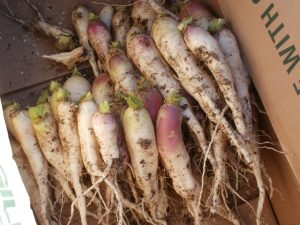 Our new radish population grew well in 2016 and showed off its reddish highlights in roots destined for winter storage.
Our new radish population grew well in 2016 and showed off its reddish highlights in roots destined for winter storage.
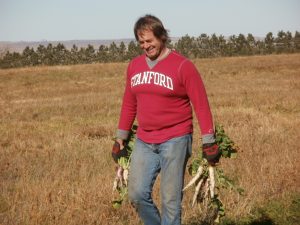
NPSAS Executive Director Edd Goerger took part in our radish digging field day near Selby, SD. Other outreach for the project has included ongoing posts to the NPSAS Farm Breeding Club Facebook page and photos and notes about the project in the NPSAS Germinator Newsletter. Photos of cowpeas growing luxuriously in Puerto Rico were especially eye catching. We produced and posted several videos to YouTube (see Impact of Results/Outcomes section above). Workshops about our cover crop work were featured at NPSAS Winter Conferences through January, 2017, including during the SARE event held in 2015. We also presented our work at a Minnesota Organic Conference and a ND Local Foods Conference. 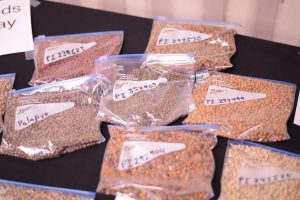
The NPSAS and other winter conferences provided excellent opportunities to talk about cowpea and radish cover crops. We analyzed the most critical cowpea data and presented it in table form to Farm Breeding Club members, collaborating agronomists, and others every fall/winter from 2013 onward to include more in the choice of varieties to move forward. This was shared via email and our other outreach media and also shown at workshops. Together with our videos and field events we gave farmers and researchers of our region many opportunities to participate. Up to twenty-five did so each year. Similarly, our field day to evaluate radish at Carrington, ND in 2016 provided for useful consideration of moving our radish population forward when the Farm Breeding Club met in February, 2017.
Project Outcomes
Areas needing additional study
Additional breeding and selection within cowpea and radish appears likely to increase their utility for our region. There is a great deal of genetic variation with which to work. Also, more variety trial work across the region to better identify areas of adaptation and to determine economic performance could be useful as new varieties are developed and released. Preliminary evaluations of radish biomass appear to suggest some important variation in root mass among the varieties. Given our experiences, it appears likely that more work with other cover crop species could improve adaptation and seed production opportunities for them as well. Finally, a harder look at the opportunities in food markets could prove valuable as all marketing opportunities are considered to provide greater sustainability to these seed production efforts. 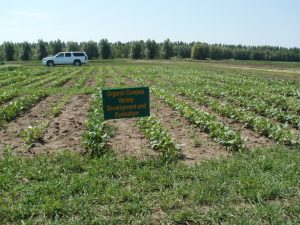 Partnerships with university agronomists made this cover crop development project possible.
Partnerships with university agronomists made this cover crop development project possible.
Information Products
- Presentation from 2015 Farmers Forum at NPSAS Conference PDF (Conference/Presentation Material)
- FBC Facebook page (Website)
- Participatory Evaluation of Cowpea Varieties for Northern Regions (Video)
- Cowpea and Radish Cover Crop Seed, Frank Kutka, ND (Video)
- Cowpea Cover Crop Seed, Erin Silva, WI (Video)